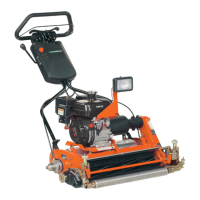4-28 4203781 First Edition
ELECTRICAL
4
Start Circuit—Theory of Operation
Unswitched Power Circuit
Unswitched power is available from the battery positive
terminal to the starter motor battery terminal and then
from the starter motor battery terminal to 50-amp circuit
breaker (F1) battery terminal. Unswitched power is
available through the 50-amp circuit breaker (F1) to
30-amp circuit breaker (F2) input terminal and from
circuit breaker (F2) input terminal to 10-amp circuit
breaker (F5).
Unswitched power is available from 30-amp circuit
breaker (F2) output terminal to accessory relay terminal
30.
Unswitched power is provided from 10-amp circuit
breaker (F5) to PTO switch terminal E.
Interlock Circuit
The interlock circuit provides 12 volts to the key switch.
The following must occur before the key switch is
provided with 12 volts:
• PTO switch in the off position
• Park brake switch in the on position
With the PTO switch in the off position and park brake
switch in the on position, voltage is provided from the
park brake switch to key switch terminal B.
Switched Power Circuit
When the key switch is turned to the run position, voltage
is provided from key switch terminal I to accessory relay
terminal 86, energizing the relay. With the relay
energized, switched power is provided from accessory
relay terminal 87 to fuel shutoff hold-in coil and to 10-amp
circuit breaker (F6).
Switched power is provided from 10-amp circuit breaker
(F6) to the fuel pump. With switched power provided to
the fuel pump, the fuel pump starts to operate.
Start Circuit
When the key switch is turned to the start position,
voltage is provided from key switch terminal S to the
starter motor solenoid, energizing the solenoid. With the
starter solenoid energized, voltage is provided from the
starter solenoid contacts to the starter motor, engaging
the motor.
Key switch terminal S also provides voltage to fuel pull-in
relay terminal 86, energizing the relay. With the relay
energized, voltage is provided to the fuel shutoff solenoid
pull-in coil, energizing the coil. With the pull-in coil
energized, the solenoid plunger retracts. When the
solenoid plunger is fully retracted, an internal switch
opens the pull-in coil circuit. This prevents extended
activation of the high-current pull-in coil. The hold-in coil
keeps the solenoid plunger in the retracted position until
it is de-energized. With the solenoid plunger retracted,
fuel is allowed to flow, and as the starter motor cranks the
engine, the engine starts operating.

